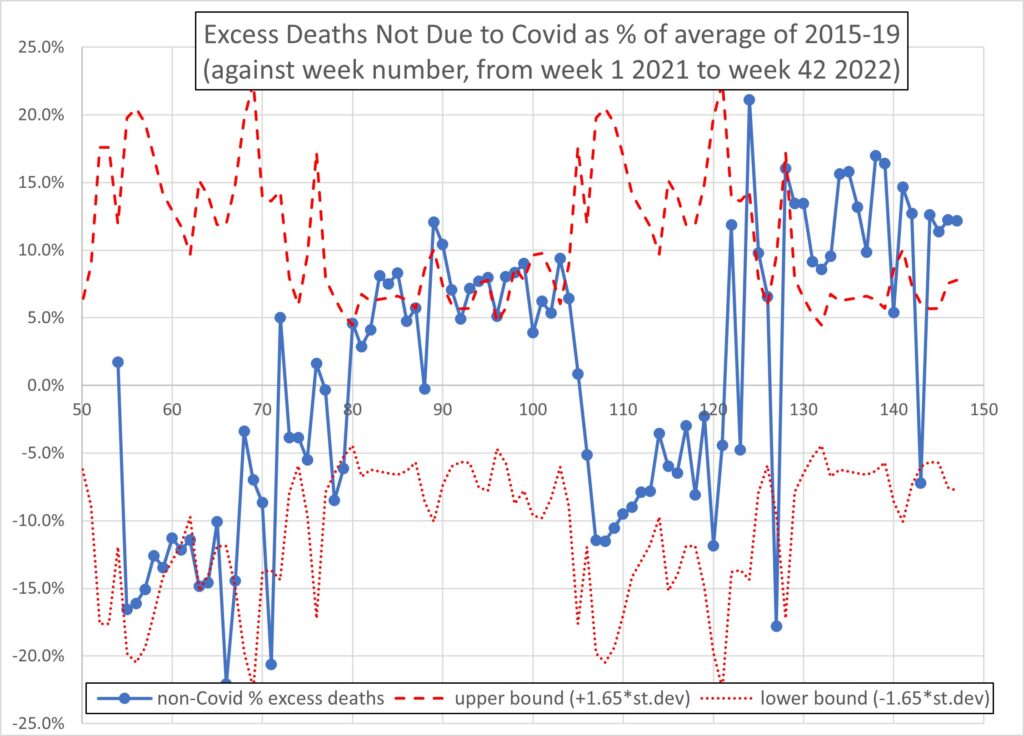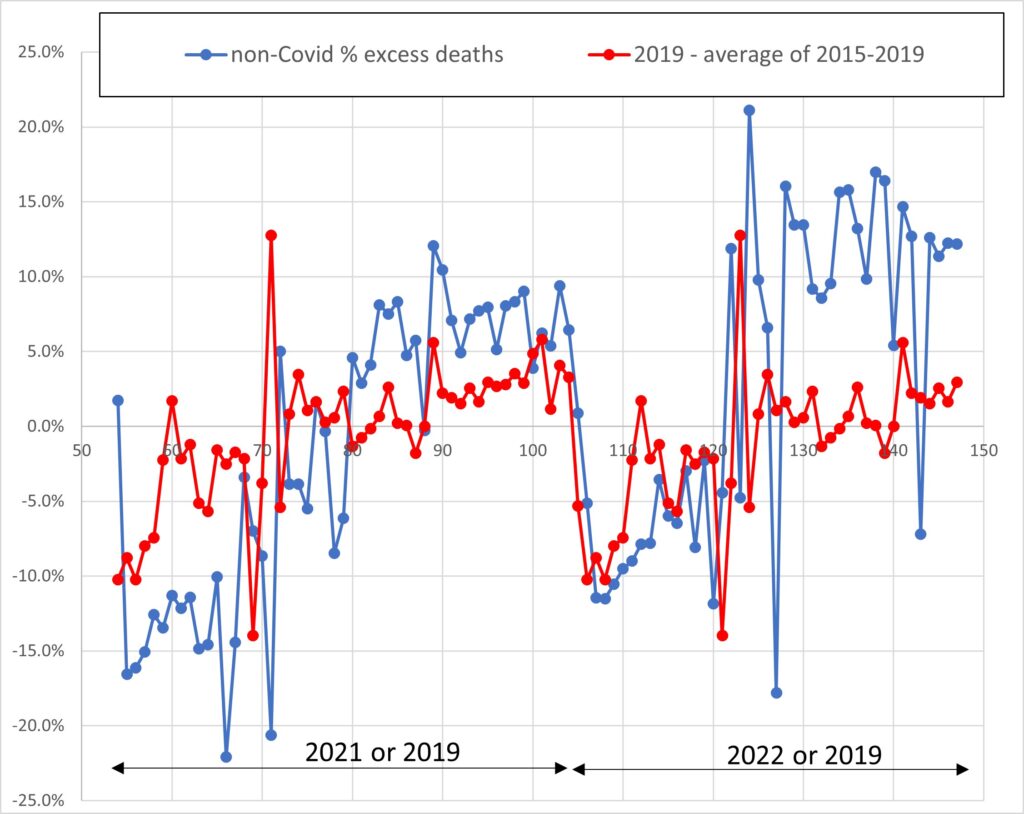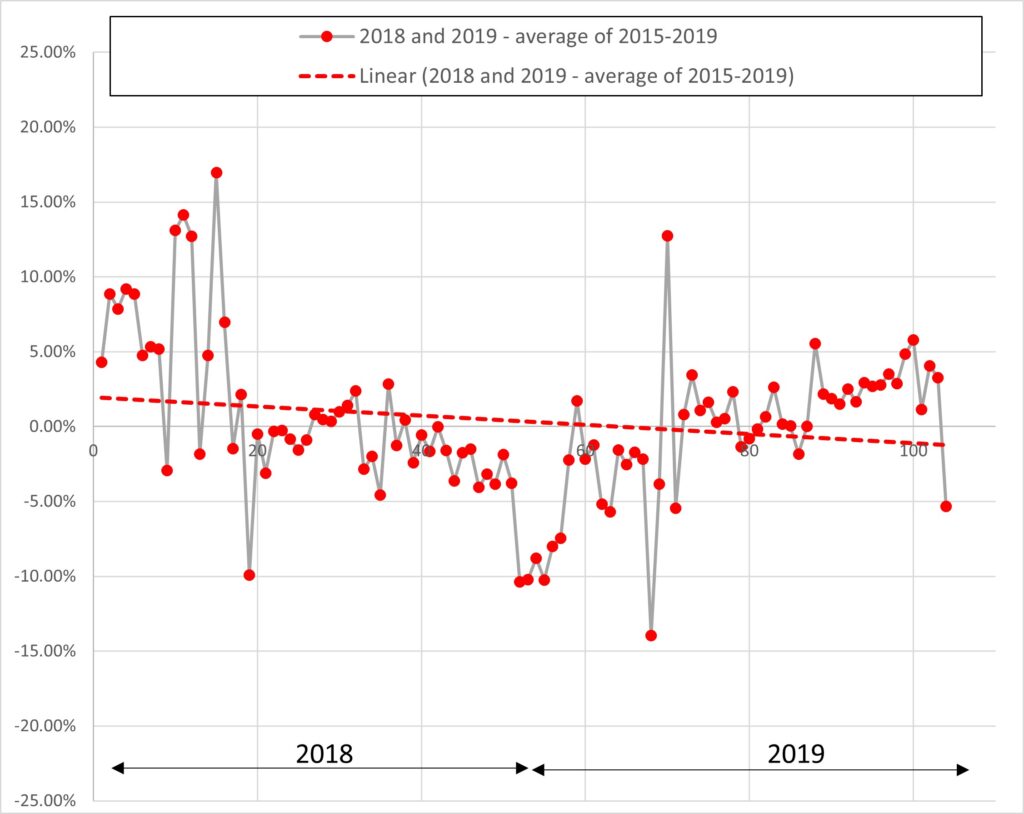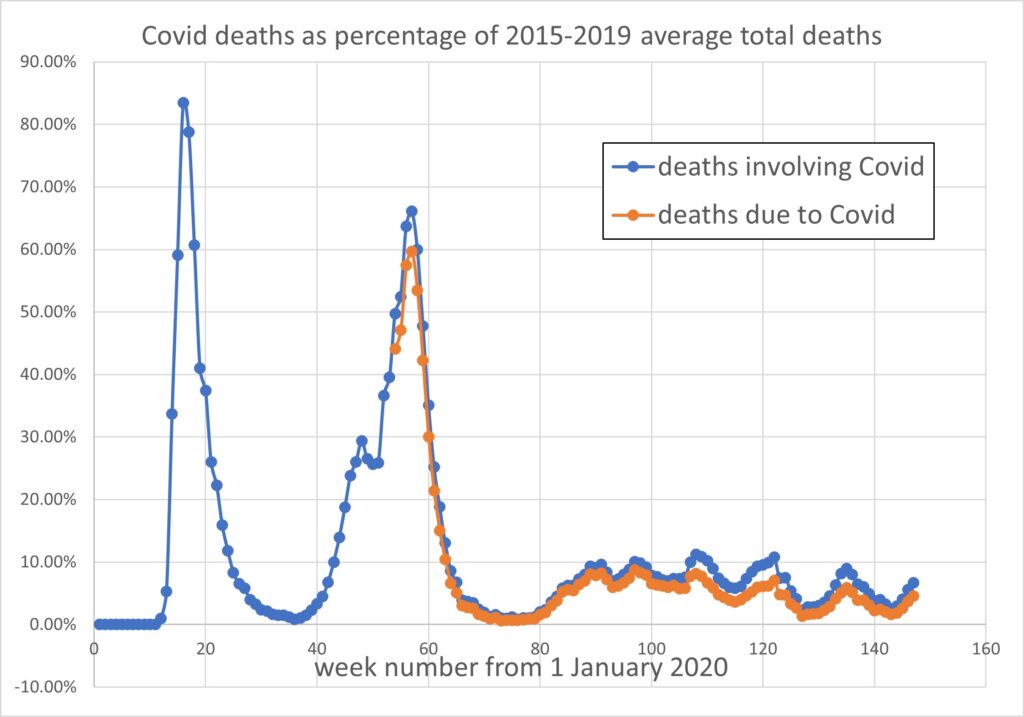For the last few months there have been many reports of non-Covid excess deaths being abnormally high. I have been tracking the issue with a view to establishing if non-Covid deaths exceed expectation to a degree which is statistically significant. Initially the matter was not clear. It is now.
I use the ONS weekly death datasets for England and Wales.
There are ambiguities in what is meant by “non-Covid deaths” and in what datum is used from which to measure excess deaths. These I now clarify.
Since January 2021 the ONS has reported two figures for “Covid deaths”. One is “deaths involving Covid-19” and the other is “deaths due to Covid-19”. The latter is a smaller figure than the former. Consequently there are two corresponding definitions of “non-Covid deaths”, namely “deaths not involving Covid-19” and “deaths not due to Covid-19”. The latter is the larger figure and I shall use “deaths not due to Covid-19” as my definition of non-Covid deaths here. This avoids any non-Covid deaths hiding under the cloak of Covid.
The second issue is the datum used to define the expected number of deaths per week across the year. Here I use simply the average of the weekly deaths over the five years 2015 to 2019. The ONS also use this definition for the excess deaths in 2020 and 2021. But, rather oddly, in 2022 they change to a different datum. This is specified in the above datasets, thus,
“The 2015 to 2019 five-year average was used to compare against deaths registered in 2020 and 2021. Deaths registered in 2022 will be compared with the 2016, 2017, 2018, 2019 and 2021 five-year average.”
This is peculiar for two reasons. Firstly it destroys the comparability of the excess deaths between 2022 and the previous two years. This alone makes it undesirable. But in addition, by including year 2021 in the averaging, Covid deaths are being included in defining a datum of normality which is clearly an inappropriate benchmark for non-Covid deaths! Worse, if there were any other abnormalities in the death statistics in 2021, for example collateral effects associated with, but not due to, Covid, such as lockdown or vaccine effects, these would also be spuriously incorporated in a datum which purports to define normality. To reiterate, here I shall use the 2015-2019 average as the datum for excess deaths throughout.
Figure 1, which heads this post, plots the weekly non-Covid excess deaths defined in this way, and as a fraction of the datum, from the start of January 2021 to the end of October 2022 (week 42). The x-axis is the week number starting from 1 January 2020 as the origin.
The dashed line on the graph is the best-fit line, i.e., a linear regression. The significance of the temporal variation is extremely high. For the slope coefficient, t = 6.8, p = 10^-9, F = 45.9, F-significance = 10^-9, R = 0.58, R-squared = 0.33.
The trend is an increase in non-Covid excess deaths of 11.4% per year (the slope of 0.0022 times 52).
On the face of it this is extremely concerning, though one cannot be sure that the trend will continue in 2023.
Also, to-date, the total excess non-Covid deaths over a full year has not been large due to negative excess deaths over a large proportion of the time. The net excess non-Covid deaths over the whole of 2021 was -2.1%, i.e., less than expectation. However, in the first ten months of 2022 this has become positive, 2.5%. This may not seem large but this will be a percentage of more than half a million deaths over a full year. So far in 2022 (to end-October) there appears to have been 10,728 excess non-Covid deaths.
The above regression tests only the significance of the trend. There is also the issue of whether recent weekly non-Covid deaths are significantly different from expectation on a week-by-week basis. This can be established by using the corresponding ONS datasets for years 2010 to 2019 to establish what variability is to be expected – and how this varies by week number over the year. I have carried out this programme in two ways.
Firstly, for each week, the coefficient of variation of the ten death data (years 2010 to 2019) is found. Multiplying this by +/-1.65 defines upper and lower 95% confidence levels for each week. These levels vary from week to week. These upper and lower bounds are plotted in comparison to the percentage excess non-Covid deaths in Figure 2. Provided the excess death line lies between the two red dashed/dotted lines the weekly excess deaths do not differ from expectation at the 95% confidence level. This was the case (just!) until the beginning of July 2022 (week 130 on the Figure). Over the last four months the weekly numbers of non-Covid deaths have been significantly in excess of expectation at the 95% confidence level.

The second method to examine significance is simply to use the maximum and minimum of the weekly death data in years 2010 to 2019, expressed as a fraction of their mean. These also provide upper and lower bounds which are compared with the percentage non-Covid excess deaths in Figure 3. It is very similar to Figure 2 and supports the same conclusion.

The Structure in Figure 1
That the excess death data, Figure 1, has a periodic structure over one year is not at all surprising – it would be odd if it did not. However, that the excess deaths are negative in roughly the first four months of each calendar year, then positive in the second half of the year, is more mysterious (to me, anyway).
The origin of this change of sign can be seen in Figure 4 which plots the actual numbers of deaths not due to Covid from January 2021 to October 2022, in comparison with the 2015 – 2019 average. Note that it is consistently found (in all years 2010 to 2021) that the last week of the year (week 52) has an anomalously low death count. I presume this is an accounting error due to it being Christmas week, some deaths that should be counted in week 52 get picked up in the new year’s weeks 1 or 2 instead. This accounts for the obvious discontinuity across the new year seen in Figure 1.
However I do not know what causes the persistent year-wide difference between the pre-pandemic expectation and the years 2021 and 2022 seen in Figure 4.
Figure 5 compares the percentage 2021/2022 non-Covid excess deaths with the 2019 data (repeated for comparison). A similar structure is apparent in 2019, with excess deaths ramping up from negative to positive over the year, suggesting that the cause of this in 2021 and 2022 is not unique to the Covid period – although the phenomenon was less marked in 2019. Moreover, this trend disappears in Figure 6 which plots 2018 and 2019 percentage excess deaths. The trend over these two years was slightly downwards (probably insignificant).
Conclusions
In respect of England and Wales…
Excess deaths not due to Covid-19 show a statistically significant upward trend between January 2021 and October 2022. The mean trend is +11.4% per year.
The weekly deaths not due to Covid-19, from the start of July 2002 to the end of October 2022, are in excess of expectation based on the 2015 to 2019 average at the 95% confidence level.
On the face of it this is concerning, but trends do not necessarily continue into the future. These data need watching as we move into 2023.
Excess deaths not due to Covid-19 are negative in the first four months of both 2021 and 2022, but positive in the second half of these years. I have not identified why.



Addendum
For comparison here are the deaths due to Covid…


